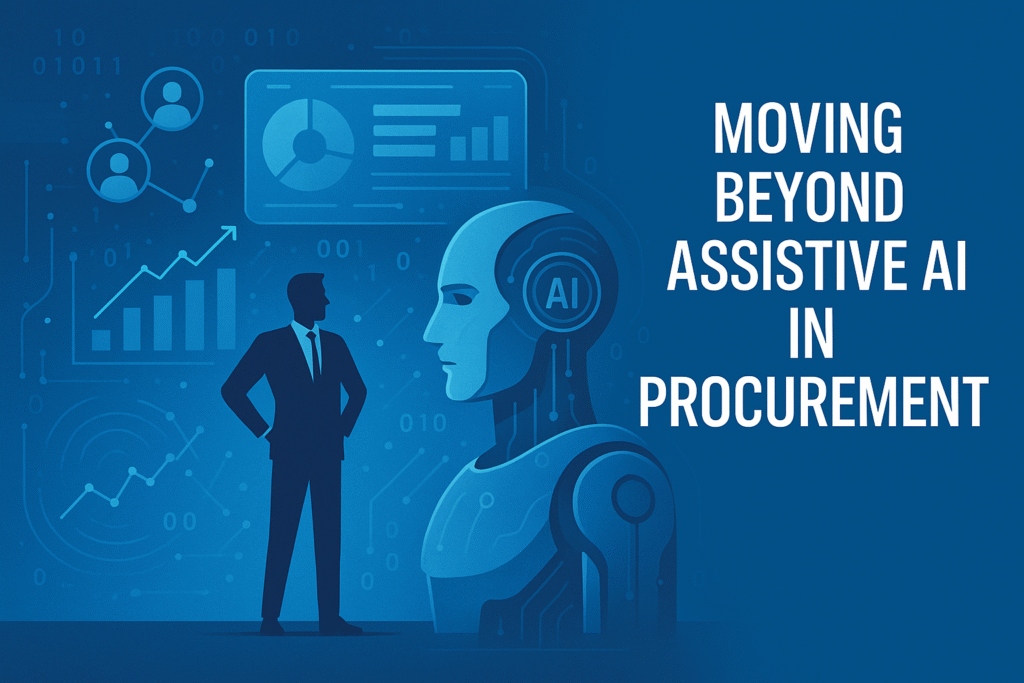From Assistive to Autonomous: The Evolution of AI in Procurement
By JD Woods
The rapid maturation and ease of access to assistive AI platforms like ChatGPT and CoPilot have sparked a polarized reaction, especially on platforms like LinkedIn. It seems everyone has an opinion, and most fall into one of two camps: either “AI gets everything wrong” or “AI is the future, use it or be left behind.” Whether “getting left behind” is truly a choice is a conversation best left to economists and futurists.
What’s often missing from these debates is a meaningful discussion of how AI will actually revolutionize our economy and workplaces. Spoiler alert: it’s not by writing your emails or generating your next marketing plan.
AI’s true business potential lies in handling the mundane tasks where the decision framework can be reverse-engineered from outcomes and repeated at scale. Machine learning thrives where data is structured and connectivity is strong. That’s why one of the first, and arguably most productive, frontiers for AI transformation is purchasing and procurement.
Most organizations exploring AI in procurement settle for half measures. They deploy “assistive AI” tools that help humans make better purchasing decisions, but stop well short of allowing machines to make those decisions autonomously. The result? Faster, more accurate transactions… but still limited by human bandwidth.
Fully autonomous purchasing agents are not only possible, they’re also the logical next step. As enterprise leaders, now is the time to shift from “AI-augmented operations” to “AI-driven decision-making.”
Let’s look at where we are today—and what comes next.
The Current Landscape: Assistive AI in Procurement
Many of the top procurement platforms in use today—think GEP SMART, Coupa, SAP Ariba, Ivalua, Zycus, SynerTrade, and Tipalti—leverage AI to assist human users with discrete tasks such as:
Spend analysis, demand forecasting, and supplier discovery
Supplier recommendations, savings detection, and fraud mitigation via AI agents
Invoice matching, contract intelligence, and predictive analytics
Invoice OCR, payment automation, and vendor onboarding (with Tipalti reporting up to 80% reduction in AP workload)
These tools excel at automation and analysis but are not yet capable of independently managing supplier networks or executing transactions.
“According to the 2025 ProcureCon Chief Procurement Officer Report, 90 percent of procurement leaders have considered or are already using AI agents to optimize operations in the year ahead.”
Semi-Autonomous Procurement Tools: A Transitional Step
Specialized platforms, like Coupa Navi, LevaData, Resilinc, and Ramp, are taking things a step further by introducing semi-autonomous features:
Conversational AI that guides procurement decisions, with limited automation
Predictive sourcing suggestions and scenario simulations for evaluation
Risk monitoring via AI, with human intervention still required for resolution
Workflow automation that routes purchasing decisions without final execution authority
These tools blend automated triggers with human oversight. They’re miles ahead of where we were even a year ago—but still don’t tap the full potential of dedicated, autonomous AI deployments.
The Very Near Future: Fully Autonomous Procurement Agents

A fully autonomous agent in procurement will be capable of Identifying demand, selecting a supplier, negotiating price, Executing the purchase, and logging the transactions, all without human input.
While no major vendor offers this as a fully mature commercial product yet, several organizations and institutions are well along in development stages (CerebrumX, Beyond Intranet, UK G-Cloud frameworks, MIT, Stanford, and INSEAD):
AI that connects demand forecasting directly to transactional systems.
Defense procurement pilots in Europe are exploring autonomous sourcing bots.
Academic research is also focused on autonomous procurement in supply chain logistics.
Progress is deliberate, as removing humans from the loop introduces complexity and risk—but the trajectory is clear.
Why Go Fully Autonomous?
Shifting from assistive to autonomous systems offers tangible benefits:
Speed: Cycle times reduced from days to seconds
Cost: Lower labor costs and better sourcing economics
Scale: Capacity to manage thousands of concurrent transactions
Resilience: Real-time response to disruptions and supply chain shocks
Learning: Continuous improvement through closed-loop feedback
Risks and Limitations to Consider
Despite the significant upside, before we turn autonomous purchasing agents loose to negotiate killer contracts, eliminate all of our stock-outs, and reduce our total cost of inventory, several constraints will need to be addressed:
Data Integrity: AI needs structured, accurate, and complete datasets
Compliance: Regulatory constraints and purchasing policy complexities can limit autonomy
Transparency: Algorithms must be explainable and auditable to avoid bias
Organizational Readiness: Resistance to change and skills gaps can slow adoption
System Maturity: No “plug-and-play” solution for full autonomy currently exists
Final Thought
Organizations that stick with assistive AI are gaining productivity—but not transformation. The real value lies in trusting AI not just to analyze, but to act.
The autonomous era of procurement isn’t science fiction. It’s a strategic advantage, and it’s already on the runway. Procurement leaders who embrace the shift today will set the standards others struggle to catch up with tomorrow.
JD Woods is the founder of The Weiwood Group, a business strategy and operations consultancy dedicated to helping organizations simplify, scale, and succeed.

